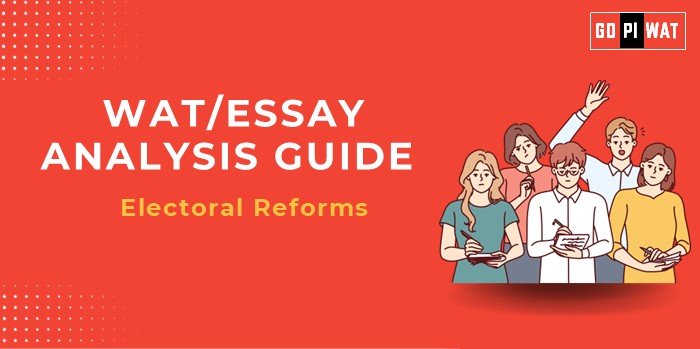📋 Written Ability Test (WAT)/Essay Analysis Guide: Electoral Reforms
🌐 Understanding the Topic
Electoral reforms are critical to addressing the declining trust in democracies worldwide. From combating misinformation to managing rising costs, they hold the key to ensuring transparency and accessibility.
📝 Effective Planning and Writing
- ⏱️ Time Allocation (30 minutes):
- Planning: 5 minutes.
- Writing: 20 minutes.
- Review: 5 minutes.
💡 Introduction Techniques for Essays
- ⚖️ Contrast Approach: “While democracy promises equality, declining voter turnout from 68% (1990) to 62% (2022) reveals a growing trust deficit. Electoral reforms offer a pathway to restore faith in democratic processes.”
- 🔍 Solution-Based: “Electoral reforms, like India’s VVPAT, which reduced voting discrepancies by 95%, demonstrate how transparency can rebuild trust in democracies.”
📚 Structuring the Essay Body
🏆 Achievements
- ✅ Technological milestones like India’s VVPAT.
- 🌍 Increased diversity through electoral quotas.
⚠️ Challenges
- 💰 High global election costs ($10 billion annually).
- 📢 Fake news affecting 58% of voters in 2023.
🔮 Future Outlook
- 🔒 Use of blockchain for secure, auditable elections.
- 🌐 Collaboration to combat misinformation globally.
📄 Concluding Effectively
- ⚖️ Balanced Conclusion: “Electoral reforms are necessary but require systemic efforts to address misinformation, rising costs, and accessibility challenges.”
- 🌏 Global Example Conclusion: “Lessons from Estonia’s e-voting success and India’s VVPAT adoption highlight the potential of reforms to restore trust in democracies worldwide.”
📊 Analyzing Successes and Shortcomings
🌟 Successes
- ✅ Increased auditability through VVPAT.
- 📊 Enhanced representation through quotas.
⚠️ Challenges
- 📢 Misinformation campaigns affecting voter trust.
- 💰 Financial burdens of reforms.
🌍 Global Context
- 🌟 Estonia and India serve as models of reform success.
- 🇺🇸 The U.S. highlights ongoing electoral challenges.
✨ Recommendations for Sustainable Progress
- 📘 Expand digital literacy programs to bridge access gaps.
- 🤖 Invest in AI-based tools to counter misinformation.
- 🔍 Strengthen oversight and transparency in electoral financing.
✍️ Sample Short Essays
⚖️ Balanced Perspective (100 words):
“Global voter turnout has declined to 62% (2022), reflecting waning trust in democracies. Electoral reforms like India’s VVPAT have enhanced transparency, reducing voting discrepancies by 95%. However, misinformation, rising costs, and accessibility remain significant challenges. By integrating blockchain and AI-based counter-misinformation tools, democracies can restore public trust while ensuring inclusive and fair elections.”
💡 Solution-Oriented (100 words):
“Electoral reforms can address the growing distrust in democracies, as demonstrated by India’s VVPAT success. However, global issues like misinformation, which impacted 58% of voters in 2023, and rising election costs ($10 billion annually), call for urgent measures. Innovations like blockchain voting and enhanced oversight can ensure transparency, accessibility, and fairness, revitalizing trust in democratic systems.”
🌍 Global Comparison (100 words):
“While India’s VVPAT reduced voting discrepancies, Estonia’s secure e-voting system showcases another model of electoral reform success. In contrast, rising costs and misinformation remain challenges globally, with 58% of voters encountering fake news during 2023 elections. By adopting technological solutions and global collaborations, democracies can overcome these hurdles and restore trust in their electoral processes.”


